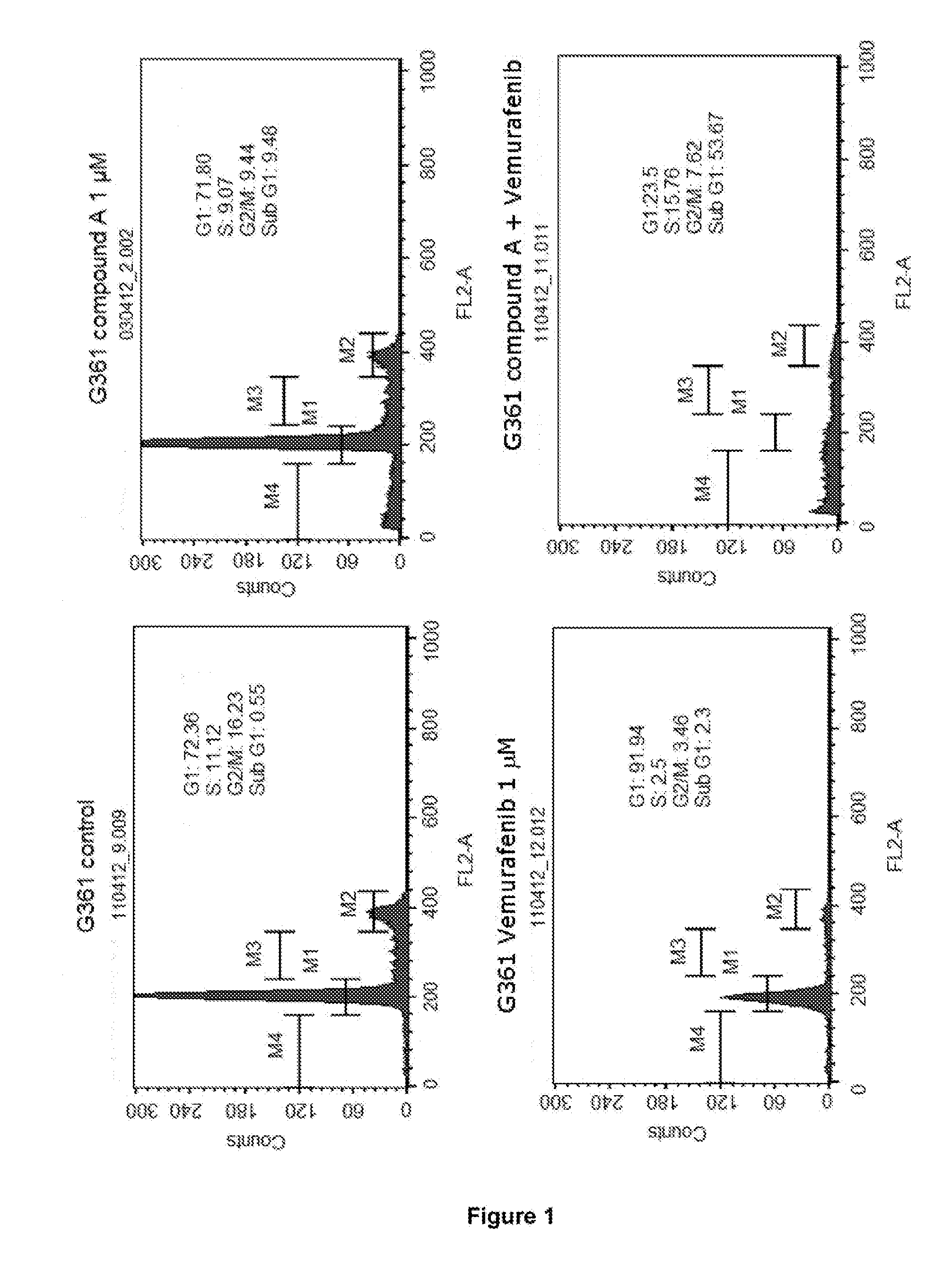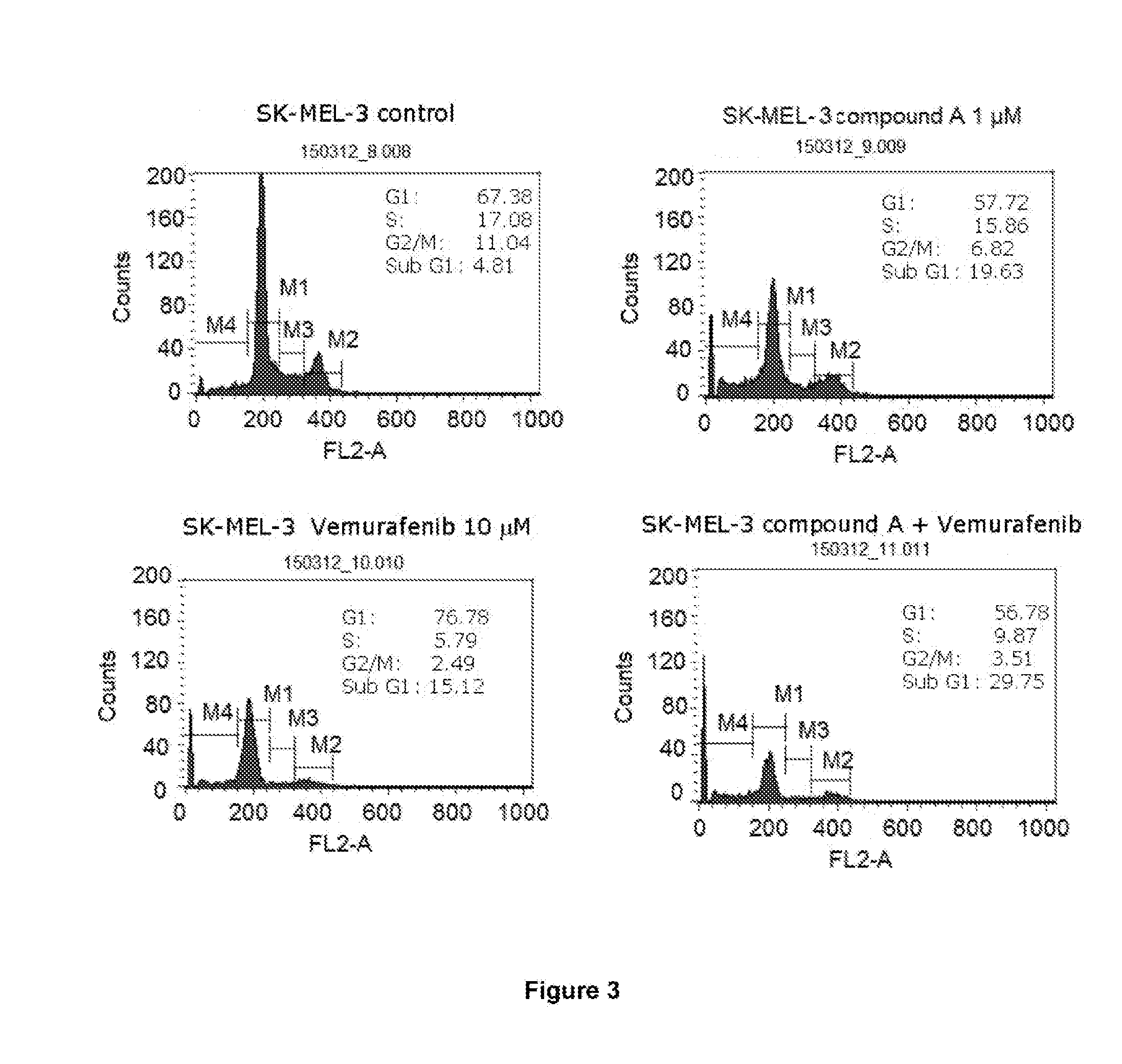A pharmaceutical combination for the treatment of melanoma
a technology of melanoma and combination therapy, applied in the field of melanoma drug combination therapy, can solve the problems of poor response rate, poor overall survival, and ineffective treatment of metastatic melanoma
- Summary
- Abstract
- Description
- Claims
- Application Information
AI Technical Summary
Benefits of technology
Problems solved by technology
Method used
Image
Examples
reference example 1
(a) Preparation of (+)-trans-2-(2-chloro-4-trifluoromethylphenyl)-8-(2-hydroxy methyl-1-methyl pyrrolidin-3-yl)-5,7-dimethoxy-chromen-4-one
[0208]To a solution of n-BuLi (15% solution in hexane, 2.2 mL, 5 mmol) in THF (10 mL), maintained at 0° C. under nitrogen atmosphere, hexamethyldisilazane (1.08 mL, 5.1 mmol) was added dropwise and stirred for 15 min. To this, a solution of (+)-trans-2-chloro-4-trifluoromethylbenzoic acid 2-(2-acetoxymethyl-1-methyl-pyrrolidin-3-yl)-6-acetyl-3,5-dimethoxyphenyl ester (1.44 g, 2.5 mmol) in THF (10 mL) was added dropwise, maintaining the temperature at 0° C. After the addition, the reaction was allowed to warm to room temperature and stirred for 2.5 h. The reaction mixture was acidified with dilute HCl, and basified with 10% sodium bicarbonate to pH 8 to 9. The aqueous layer was extracted with chloroform (3×25 mL). The organic layer was washed with water (25 mL), brine (25 mL) and dried over anhydrous Na2SO4. The organic layer was concentrated unde...
reference example 2
(a) Preparation of (+)-trans-2-(2-chlorophenyl)-8-(2-hydroxymethyl-1-methyl pyrrolidin-3-yl)-5,7-dimethoxy-chromen-4-one
[0214]Sodium hydride (50%, 0.54 g, 11.25 mmol) was added in portions to a solution of (−)-trans-1-[2-hydroxy-3-(2-hydroxymethyl-1-methyl pyrrolidin-3-yl)-4,6-dimethoxyphenyl)-ethanone (0.7 g, 2.2 mmol) in dry DMF (15 mL) at 0° C., under nitrogen atmosphere and with stirring. After 10 min., methyl 2-chlorobenzoate (1.15 g., 6.75 mmol) was added. The reaction mixture was stirred at 25° C. for 2 h. Methanol was added carefully below 20° C. The reaction mixture was poured over crushed ice (300 g), acidified with 1:1 HCl (pH 2) and extracted using EtOAc (2×100 mL). The aqueous layer was basified using a saturated Na2CO3 (pH 10) and extracted using CHCl3 (3×200 mL). The organic layer was dried (anhydrous Na2SO4) and concentrated. To the residue, conc. HCl (25 mL) was added and stirred at room temperature for 2 h. The reaction mixture was poured over crushed ice (300 g) a...
example 1
[0220]I. In Vitro Study Involving Use of Combination of Compound A (CDK Inhibitor, also Referred to as Voruciclib) and Vemurafenib (BRAFV600E Inhibitor) in BRAFV600E Mutated Melanoma Cell Lines
Objective:
[0221]To study the effect of the combination of compound A (CDK inhibitor, also referred to as voruciclib) and vemurafenib (BRAFV600E inhibitor) on the cell cycle and apoptosis in BRAFV600E mutated melanoma cell lines.
Materials and Methods:
Cell Lines
[0222]G361 and SK-MEL3 melanoma cell lines obtained from ATCC (American Type Culture Collection), USA, were used in this study. G361 is vemurafenib sensitive cell line while SK-MEL3 is vemurafenib resistant cell line. Both the cell lines are BRAFV600E mutated.
A. Analysis of Cell Cycle Distribution Using Flow Cytometry:
[0223]The G361 / SK-MEL3 melanoma cells were seeded in 25 mm3 tissue culture flasks. After 24 h, G361 cells were treated with: i) compound A (1 μM); ii) vemurafenib (1 μM); and iii) compound A (1 μM) and vemurafenib (1 μM) tog...
PUM
| Property | Measurement | Unit |
|---|---|---|
| Refractory | aaaaa | aaaaa |
Abstract
Description
Claims
Application Information
 Login to View More
Login to View More - R&D
- Intellectual Property
- Life Sciences
- Materials
- Tech Scout
- Unparalleled Data Quality
- Higher Quality Content
- 60% Fewer Hallucinations
Browse by: Latest US Patents, China's latest patents, Technical Efficacy Thesaurus, Application Domain, Technology Topic, Popular Technical Reports.
© 2025 PatSnap. All rights reserved.Legal|Privacy policy|Modern Slavery Act Transparency Statement|Sitemap|About US| Contact US: help@patsnap.com



